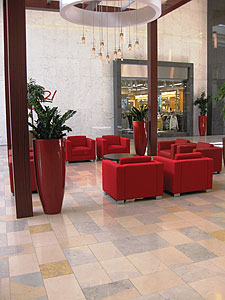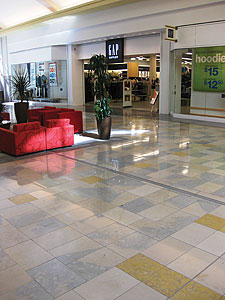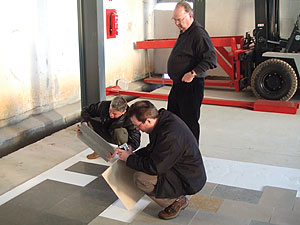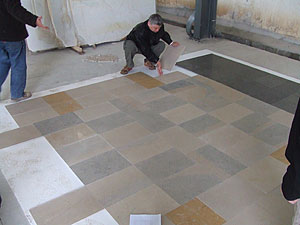
Photo by Michael Reis
Five varieties of limestone - quarried by Dimpomar of Vila Vicosa, Portugal, and supplied by Associated Imports Corp. of Atlanta, GA - were utilized in the floor design of the newly renovated Bergen Town Center in Paramus, NJ.
Five varieties of limestone - quarried by Dimpomar of Vila Vicosa, Portugal, and supplied by Associated Imports Corp. of Atlanta, GA - were utilized in the floor design of the newly renovated Bergen Town Center in Paramus, NJ.
On November 14, 1957 the Bergen Mall first opened its doors in Paramus, NJ - a shopping mecca of the New York Tri-State area. Designed by John Graham of Seattle, WA, who also designed the Space Needle for the 1962 World’s Fair in Seattle, the mall was considered to be the first of its kind. Its Grand Opening drew nationwide attention, as Dave Garroway, host of The Today Show, served as Master of Ceremonies. But through the years, the mall fell into disrepair and was in desperate need of a makeover, which didn’t begin until 2003, when Vornado Realty Trust of New York City purchased the shopping center and began plans to change its format and bring in high-profile stores. In 2006, Vornado changed the mall’s name to the Bergen Town Center, and the transformation was finally complete in the spring of 2009 - with a new floor comprised of a variety of Portuguese limestone, which was quarried by Dimpomar of Vila Vicosa, Portugal, and supplied through Associated Imports of Atlanta, GA.

Photos by Michael Reis
The majority of the tiles in the floor pattern measure 12 x 18 x 3/8 inches and have a honed finish.
The majority of the tiles in the floor pattern measure 12 x 18 x 3/8 inches and have a honed finish.
In decades to come, outdoor malls lost their appeal, so in the 1970s the Bergen Mall went under a $1.2 million renovation project. The revamped mall, which re-opened on September 16, 1973, was now enclosed and featured an Early American-themed “Village Mall” area on the lower level. With its new look, the Bergen Mall was once again competitive with other retail centers in the region.

While the field of the floor design consists of Ataíja Beige, Ataíja Blue and Ataíja Mixed limestone, 12- x 12-inch tiles of Amarelo Negrais limestone was used as accent material to form patterns.
The first major facelift to the mall, which was renamed the Bergen Town Center by then, was the introduction of Century 21 - a New York City-based discount apparel outlet. The opening of this store, which now occupies levels two and three of the four-level building, was followed by the opening of a Boston-based Filene’s Basement on October 28, 2007.
The multi-million-dollar renovation plan also included the addition of new reputable anchor stores - Target and a 77,000-square-foot Whole Foods Market. Among other new stores currently taking up residences in the Bergen Town Center is Nordstrom Rack, a Nike’s Factory Store and Tommy Hilfiger. To further entice patrons, Bobby’s Burger Palace - owned by famous chef Bobby Flay - has been added to the mall.

Photos by Michael Reis
A border is created around the field of the floor with a darker limestone called Lagos Azul.
A border is created around the field of the floor with a darker limestone called Lagos Azul.
Selecting limestone flooring
When it came time to select the flooring material that would run throughout the public spaces of the Bergen Town Center, architect Michael B. Lowry, AIA, and Design Principal Gar Muse, both of Cooper Carry of Atlanta, GA, the architecture firm responsible for the renovation, wanted to use natural stone to create a high-end look. As a result, they turned to Associated Imports Corp., also of Atlanta, to assist them in the selection process.“We’ve completed many projects for Cooper Carry around the country for about 20 years,” said Geoffrey Milspaw of Associated Imports. “We work hard for their business and every project over that time period has been very successful.”

The design team at Cooper Carry, on behalf of Vornado, chose the limestone varieties from Dimpomar’s quarries because of previous successful experiences with these particular stones, which had been supplied on other high-traffic shopping center installations.
Milspaw explained that the design team at Cooper Carry, on behalf of Vornado, chose the limestone varieties from Dimpomar’s quarries because of previous successful experiences with these particular stones, which had been supplied on other high-traffic shopping center installations.
“The client has a high level of experience designing and specifying stone, and edited the selection based on durability, cost and availability,” said Milspaw. “This selection was chosen from a large number considered.”

Photos courtesy of Associated Imports Corp.
After the design team’s initial viewing of the mock-up at its office, a trip to Dimpomar’s factory in Portugal was taken to further inspect the stone.
After the design team’s initial viewing of the mock-up at its office, a trip to Dimpomar’s factory in Portugal was taken to further inspect the stone.
Working on a tight timeframe
In total, Dimpomar supplied 10 containers over a period of three months. “It was a tight timeframe,” said Pedro Cabral, Sales Manager of Dimpomar. “Each container contained all different colors and sizes so that the installation could start immediately with the first container.”According to Milspaw, the tight timeframe was due to the fact that the order was placed late in the year. “Dimpomar had to get a couple of containers out before Christmas [of 2008],” he said. “The factory was required to produce equal amounts of the differing sizes and types, which is different than ‘production plant strategy.’ The factory wants to produce all common sizes one after the other; the installer needs a quantity of each on the first day so they have enough to do an area completely. Associated Imports needed to guide the factory through the delivery process, which resulted in all materials being delivered in the proper amounts on each container starting with the first.”

On the visit to the factory, Design Principal Gar Muse of Cooper Carry pulled tiles from a mock-up to verify the dimensions of the pieces.
Creating mock-ups
With such a variety of limestone employed for the floor design, it was important to make sure that the installer followed a mock-up to maintain consistent patterning. “We first shipped a mock-up to Cooper Carry’s office, which then went to the jobsite for owner review and approval,” said Milspaw. “The architect is keenly aware of the impact of color and character variation when selecting limestones, which made a visit to the quarry and factory imperative for final range selection and editing of the project under production for the Bergen Town Center.”So, after the design team’s initial viewing of the mock-up, Milspaw led the team, which also included Jeffrey Anderson of KrisStone, LLC of Roselle Park, NJ, - the installer for the project - on a visit to the factory in Portugal for further inspection of the stone. Moreover, Milspaw and his partner, Mark Chacon, who heads Associated Imports Corp.’s Seattle location, made several individual trips to Dimpomar’s plant to monitor the production process.
All of the limestone varieties were given a honed finish. While the majority of the pieces measured 12 x 18 x 3/8 inches, the Amarelo Negrais limestone tiles, which were used to create accent patterns, were 12 x 12 x 3/8 inches. Additionally, 25 pieces of Lagos Azul limestone were cut into 48- x 4- x 2-inch pieces and used for thresholds.
When reviewing the limestone tiles at the factory, uniformity of color and character variation were important factors to observe. “[Also], consistency of background color was critical for the accent colors to achieve the graphic pattern that was placed on top of the overall background field, which was highly varied,” said Milspaw. “Allowing for greater variation of background color for the main field stone enabled Associated Imports to maintain a reduced overall flooring budget by using all colors in the block, keeping the project natural stone verses a ceramic tile.”
Sidebar: Bergen Town Center
Paramus, NJOwner: Vornado Realty Trust, New York, NY
Architect: Cooper Carry, Atlanta, GA
Stone Quarrier: Dimpomar, Vila Vicosa, Portugal
Stone Supplier: Associated Imports Corp., Atlanta, GA
Stone Installer: KrisStone, LLC, Roselle Park, NJ
